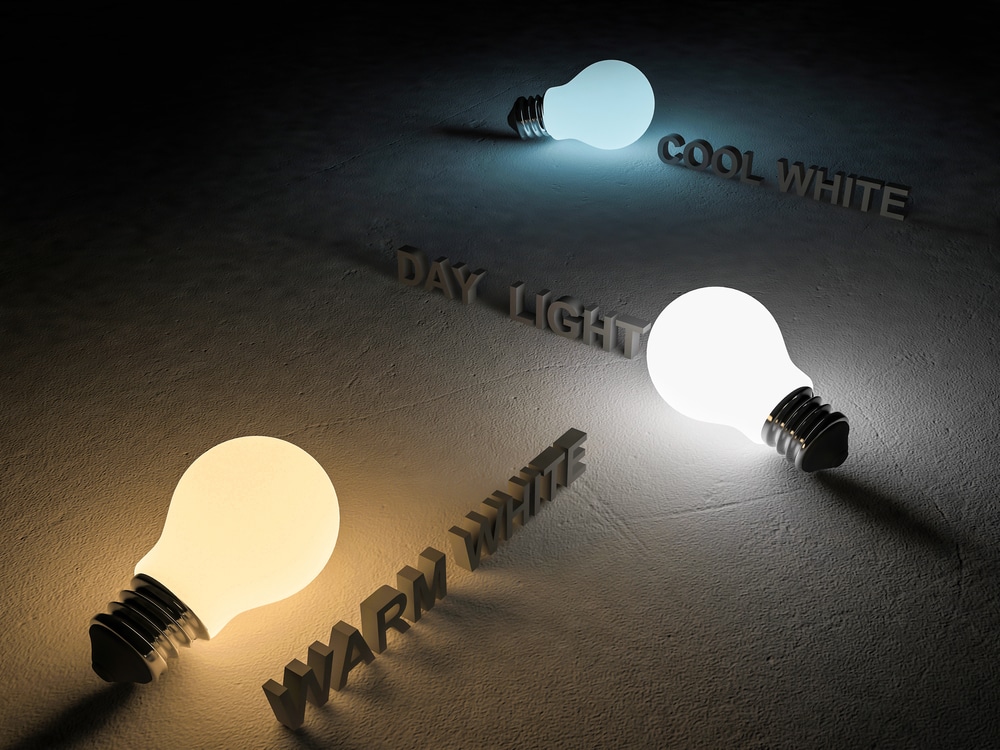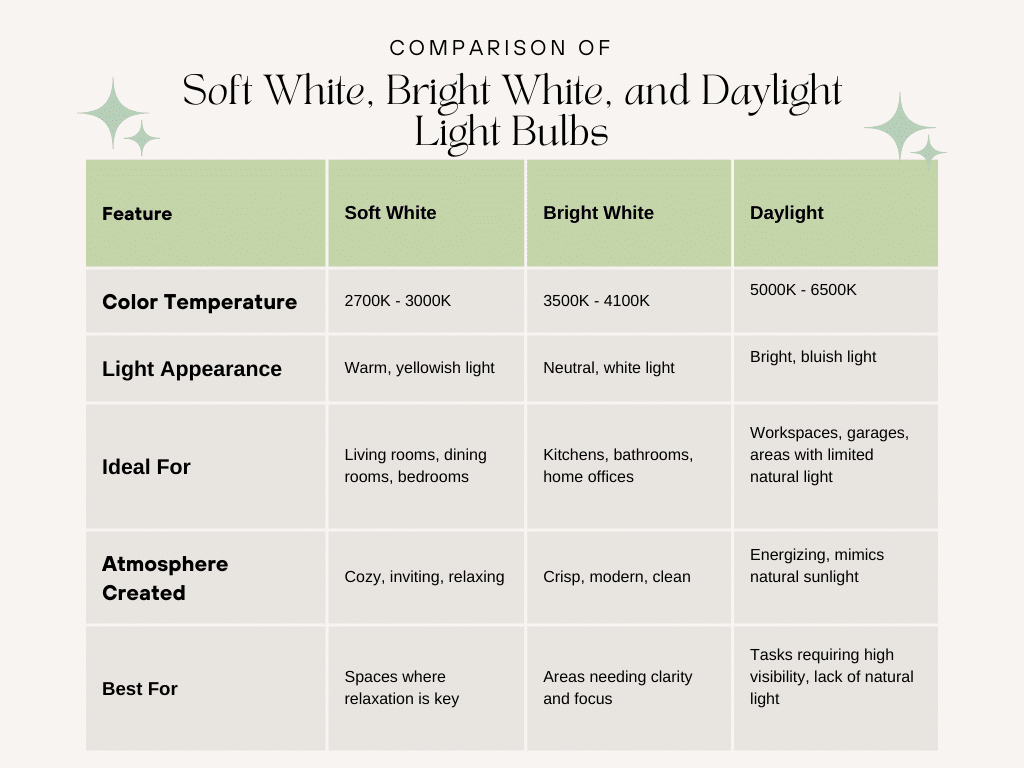Table of Contents
When it comes to creating the perfect ambiance in your home, lighting plays a pivotal role. Whether you’re setting the mood for a cozy evening or brightening up your workspace, the color temperature of your bulbs can make all the difference. But with so many options, how do you decide between soft white and bright white? These two popular lighting choices can transform a room in very different ways. In this guide, we’ll dive into the nuances of soft white vs. bright white, helping you discover the right light temperature to enhance every corner of your home compared to daylight.
Understanding Color Temperature

Before diving into the specifics of soft white vs bright white, it’s essential to understand color temperature, measured in Kelvin (K). Color temperature determines the hue and appearance of the light emitted by a light bulb.
- Lower Kelvin values (around 2700K-3000K) produce a warm light, often referred to as soft white light.
- Higher Kelvin values (3500K-4100K) result in a brighter, more neutral light, typically known as bright white.
Soft White – Creating a Cozy and Inviting Atmosphere
- Soft white bulbs emit a warm light between 2700K and 3000 K.
This color is similar to the warm glow of traditional incandescent bulbs and is perfect for creating a cozy, inviting atmosphere. Interior designers often recommend soft white light for living rooms, dining rooms, and bedrooms because it fosters relaxation and comfort.
In living rooms, soft white light bulbs can enhance the warm tones of your furniture and décor, making the space feel more intimate. The color of soft white bulbs complements earthy colors like browns, tans, and reds, adding to the room’s overall warmth. For dining rooms, soft white bulbs help create an inviting environment conducive to meals and conversation. The warm light produced by these bulbs can make the room feel welcoming and homely, perfect for family dinners or gatherings with friends.
Bright White – A Crisp and Energizing Light
- On the other hand, bright white bulbs emit a cool white light with a color temperature between 3500K and 4100K.
This type of light is more neutral and is often described as clean and modern. Bright white light is ideal for areas where clarity and focus are necessary, such as kitchens, bathrooms, and home offices. In spaces like kitchens, bright white light helps illuminate the area more effectively, making food preparation safer and more enjoyable. The crispness of bright white light enhances visibility, ensuring that you can see details clearly.
For home offices, bright white light creates a more focused and productive atmosphere. The cool white light from bright white bulbs reduces eye strain, which is particularly beneficial when working on tasks that require prolonged attention.
How to Choose the Right One?
- For a warm, cozy ambiance: Go for soft white in areas where comfort is a priority.
- For a clean, modern look: Choose bright white in places that require bright and clear visibility.
- For mixed-use spaces: Consider using dimmable LED bulbs to switch between different lighting moods.
Comparing Soft White vs Bright White

When comparing soft white vs bright white, it’s essential to consider the purpose of each room in your home. While soft white is perfect for creating a warm and cozy atmosphere, bright white is better suited for functional spaces where clarity is essential.
Living Rooms
Soft white light is typically preferred here because it creates a comfortable, inviting environment that encourages relaxation.
Kitchens
Bright white or cool white lights are ideal as they provide better illumination for tasks that require attention to detail, such as cooking.
Bathrooms
Bright white lights are often recommended for bathrooms due to their clean, bright appearance, which helps with grooming and applying makeup.
Bedrooms
Soft white is usually the better option, as the warm glow it provides promotes relaxation, helping you wind down before sleep.
Soft White vs Daylight – What’s the Difference?

When selecting LED bulbs, it’s crucial to consider the color temperature. If you’re looking for a warm or cool atmosphere, LED bulbs offer flexibility, allowing you to achieve the desired effect in any room.
Another comparison often made is between soft white vs daylight bulbs. Daylight bulbs have a higher color temperature, typically ranging from 5000K to 6500K, and emit a very bright, bluish light. The difference between daylight and soft white is stark; while soft white creates warmth, daylight bulbs mimic natural sunlight, making them ideal for areas where natural light is lacking.
Daylight versus bright white is another common comparison. Bright white light is less intense than daylight but still offers a neutral light that is closer to natural light than soft white. This makes bright white bulbs a good middle ground between the warmth of soft white and the intensity of daylight.
| Feature | Soft White (2700K – 3000K) | Bright White (3500K – 4100K) |
|---|---|---|
| Color Tone | Warm, yellowish glow | Neutral, cool white |
| Ambiance | Cozy, relaxing | Crisp, energetic |
| Best For | Bedrooms, living rooms, dining rooms | Kitchens, bathrooms, garages, workspaces |
| Mimics | Traditional incandescent bulbs | Fluorescent and daylight-like lighting |
| Effect on Colors | Enhances warm tones, makes colors appear softer | Enhances cool tones, makes colors appear sharper |
Soft White vs Bright White for Different Activities
In the debate between soft white vs bright white, there’s no definitive answer as to which is better. The choice depends on the specific needs of each room in your home. Soft white is generally better for creating a warm, inviting atmosphere, making it ideal for living rooms, dining rooms, and bedrooms. Bright white suits areas where clarity and focus are essential, such as kitchens, bathrooms, and home offices.
- Reading: Soft white is good for casual reading, while bright white is better for work or studying.
- Makeup Application: Bright white gives a clearer reflection, reducing shadows.
- Cooking & Food Prep: Bright white provides better visibility for chopping and cooking.
- Watching TV: Soft white light reduces glare and enhances relaxation.
- Working at a Desk: Bright white keeps you alert and productive.
Conclusion
Selecting the right light temperature can significantly impact the mood and functionality of your home. Whether you prefer the warm, cozy ambiance of soft white light bulbs or the crisp, clean feel of bright white light, the choice is yours. By considering the specific needs of each room and understanding the difference between soft white and daylight or bright white vs daylight, you can choose the perfect light fixtures and LED lights to enhance your home’s atmosphere.


